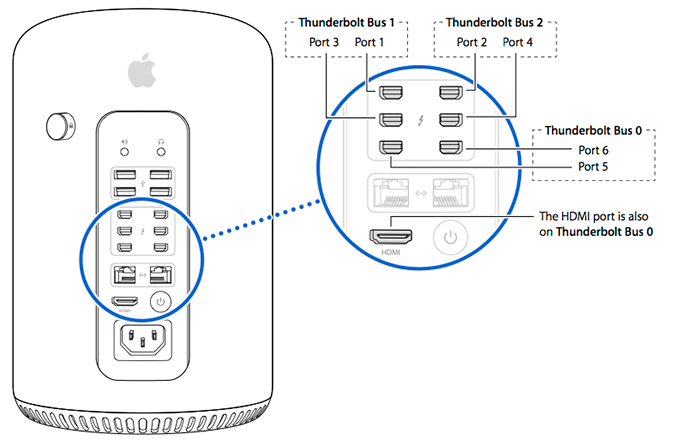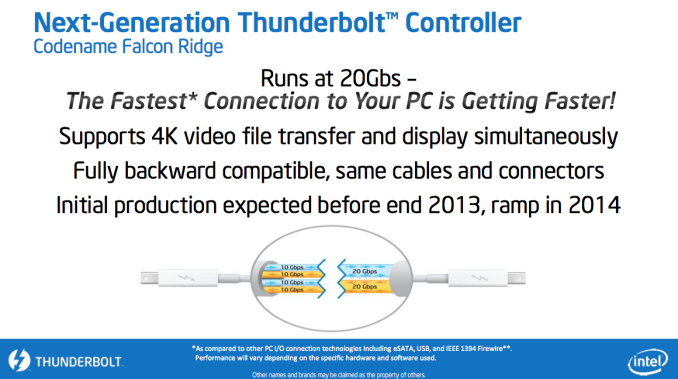The Mac Pro Review (Late 2013)
by Anand Lal Shimpi on December 31, 2013 3:18 PM ESTThunderbolt 2
The new Mac Pro integrates three Intel Falcon Ridge Thunderbolt 2 controllers. These are the fully configured controllers, each supporting and driving two Thunderbolt 2 connectors on the back of the Pro for a total of 6 ports.
Pairing Thunderbolt 2 with Ivy Bridge EP is a bit tricky as Apple uses Thunderbolt 2 for display output as well as data. Typically you’d route all display through processor graphics, but in the case of IVB-EP there is no integrated graphics core. On a DIY PC you enable display output over Thunderbolt 2 by running an extra cable out of the discrete GPU and into a separate input that muxes the signal with PCIe and ships it out via another port as Thunderbolt. Here’s where Apple’s custom PCB work comes in handy as all of this is done internal to the Mac Pro. The FirePro’s display outputs are available via any two of the six Thunderbolt 2 ports, as well as the lone HDMI port on the back of the Mac Pro.
How does Thunderbolt 2 differ from the original? For starters, it really would’ve been more accurate to call it Thunderbolt 4K. The interface is fully backwards compatible with Thunderbolt 1.0. You can use all previous Thunderbolt peripherals with the Mac Pro. What’s new in TB2 is its support for channel bonding. The original Thunderbolt spec called for 4 independent 10Gbps channels (2 send/2 receive). That meant no individual device could get access to more than 10Gbps of bandwidth, which isn’t enough to send 4K video.
Thunderbolt 2 bonds these channels together to enable 20Gbps in each direction. The total bi-directional bandwidth remains at 40Gbps, but a single device can now use the full 20Gbps. Storage performance should go up if you have enough drives/SSDs to saturate the interface, but more importantly you can now send 4K video over Thunderbolt. Given how big of a focus 4K support is for Apple this round, Thunderbolt 2 mates up nicely with the new Mac Pro.
So far I’ve been able to sustain 1.38GB/s of transfers (11Gbps) over Thunderbolt 2 on the Mac Pro. Due to overhead and PCIe 2.0 limits (16Gbps) you won’t be able to get much closer to the peak rates of Thunderbolt 2.

The impact of chaining a 4K display on Thunderbolt 2 downstream bandwidth
Here’s where the six Thunderbolt 2 and three TB2 controllers come into play. Although you can daisy chain a 4K display onto the back of a Thunderbolt 2 storage device, doing so will severely impact available write bandwidth to that device. Remember that there’s only 20Gbps available in each direction, and running a 3840 x 2160 24bpp display at 60Hz already uses over 14Gbps of bandwidth just for display. I measured less than 4Gbps of bandwidth (~480MB/s) available for writes to a Thunderbolt 2 device downstream from the Mac Pro if it had a 4K display plugged in to it. Read performance remained untouched since display data only flows from host to display, leaving a full 20Gbps available for reads. If you’re going to connect Thunderbolt 2 devices to the Mac Pro as well as a 4K display, you’ll want to make sure that they aren’t on the same chain.
If we start numbering in the top left corner of the 2 x 3 array of Thunderbolt ports and go left to right down the stack, you'll want to first populate ports 1, 2 and 5 before filling in the rest. The diagram below should help simplify:












267 Comments
View All Comments
zephonic - Tuesday, December 31, 2013 - link
Thanks for the first thorough review of the MacPro, and on the last day of 2013!Happy New Year!
solipsism - Tuesday, December 31, 2013 - link
I'm surprised that you can't have 3x4K displays all off the TB ports since the one HDMI port is connected to TB Bus 0.lilo777 - Tuesday, December 31, 2013 - link
The review is very disappointing. Normally workstation review would contain performance comparisons with other workstations not with all-in-one consumer computers equipped with mobile parts. How about comparing MP with real workstations? Perhaps that would put its size shrink into proper perspective.darkcrayon - Wednesday, January 1, 2014 - link
From the review, there's no reason to believe the Windows performance would be much different from other similarly configured workstations (which we know are of similar cost), with similar CPUs and GPUs. And of course if you need to work in Final Cut Pro, there wouldn't be an exact comparison available anyway.hoboville - Thursday, January 2, 2014 - link
"No reason to believe performance would be different".Interesting to hear you say that, as these GPUs are underclocked to meet the thermal headroom. For raw performance metrics, the gaming shows how CFX D700 compares to its consumer twin the 7970 GHz / R9 280X, it's slower. More RAM, sure, but it's not ECC which is what real workstations use. And if you're not using more than 3 GB...you're wasting money.
This is a Final Cut Pro computer or a computer for those who only use Mac software. Too bad for them, as they have to pay more for less power.
akdj - Wednesday, January 1, 2014 - link
Did you read page one? There really isn't anything to 'compare' it TOO! No one else is offering different chipsets in their workstations. PCIe SSDs are rare and thunderbolt is all but non existent so far in Windows landwiz329 - Tuesday, December 31, 2013 - link
@Ananad, does the fact that there are only 8 PCIe lanes available to the IO mean that we could see some bottlenecks if there are a large number of external devices attached/in use?wiz329 - Tuesday, December 31, 2013 - link
*Anandtipoo - Tuesday, December 31, 2013 - link
So you can't get the cards to be Firepros under Windows? I suspected something like that would be the case with the cost of actual firepros, since apple writes much of the graphics driver there's less of a difference in osx, while they seem like bog standard radeons with somewhat odd configs in Windows. That may take some value away for pros who work with high end apps in both.tipoo - Wednesday, January 1, 2014 - link
There were also reports of 7900 series Radeons showing up as D*** series FirePros in OSX. It appears Apple is just eliminating the distinction between them, just calling standard Radeons FirePros.